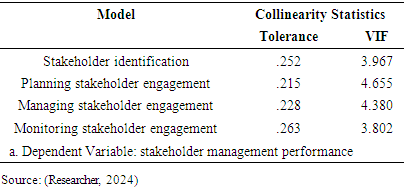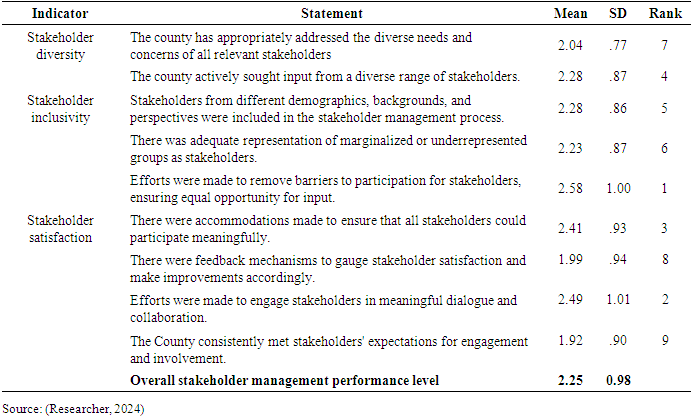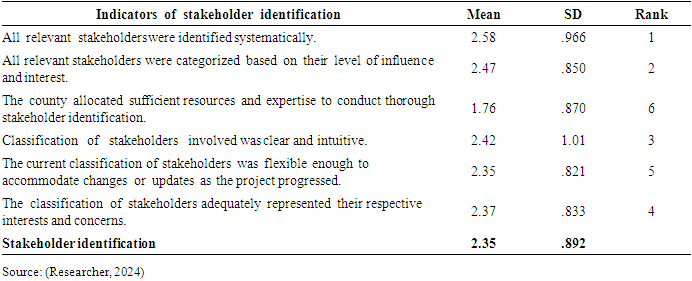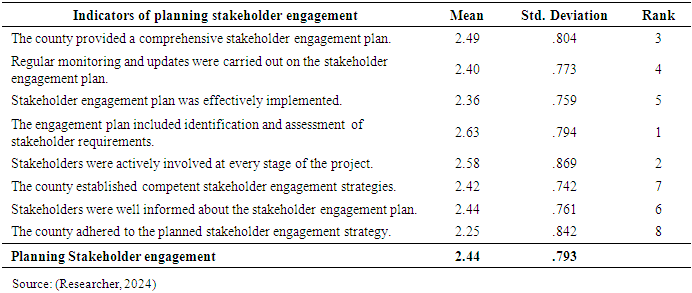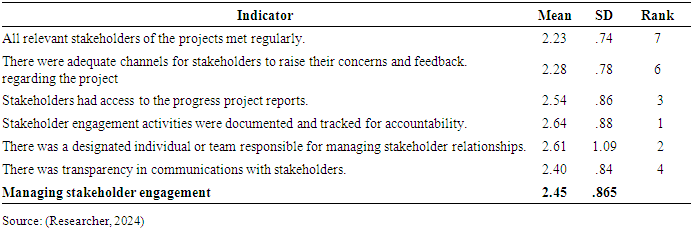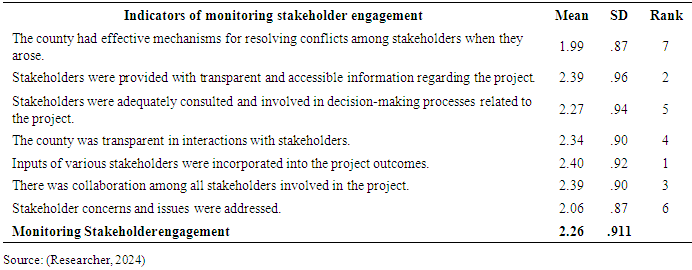-
Paper Information
- Paper Submission
-
Journal Information
- About This Journal
- Editorial Board
- Current Issue
- Archive
- Author Guidelines
- Contact Us
International Journal of Construction Engineering and Management
p-ISSN: 2326-1080 e-ISSN: 2326-1102
2025; 14(2): 41-52
doi:10.5923/j.ijcem.20251402.01
Received: Feb. 2, 2025; Accepted: Mar. 3, 2025; Published: Mar. 17, 2025

A Framework for Effective Stakeholder Management for County Government-Funded Construction Projects: A Case of Machakos County
Juliet Ngusye Muinde, Shadrack Mutungi Simon, James Ouma Okaka
Department of Construction Management, Jomo Kenyatta University of Agriculture and Technology, Nairobi, Kenya
Correspondence to: Juliet Ngusye Muinde, Department of Construction Management, Jomo Kenyatta University of Agriculture and Technology, Nairobi, Kenya.
| Email: |  |
Copyright © 2025 The Author(s). Published by Scientific & Academic Publishing.
This work is licensed under the Creative Commons Attribution International License (CC BY).
http://creativecommons.org/licenses/by/4.0/

Stakeholder management is a pivotal aspect of construction projects funded by county governments in Kenya. In Kenya, public infrastructure projects often face delays and budget overruns. Therefore, robust stakeholder management practices are essential for ensuring successful project implementation and better stakeholder management performance. This study aimed to develop a framework for effective stakeholder management for County Government-funded construction projects in Kenya. The specific objectives of this study were: to determine the current state of stakeholder management performance in County Government-funded construction projects, to establish the existing stakeholder management practices in County Government-funded construction projects, and to establish the influence of stakeholder management practices on stakeholder management performance in County Government-funded construction projects. The study adopted a survey research design. The data was collected using questionnaires and measured using a 5-point Likert scale. Simple stratified sampling was used to identify the 254 respondents. The respondents included: contractors, project consultants, end users, ward development officers, PMC representatives, ward administrators, and village administrators. The collected data were coded and entered into Statistical Packages for Social Scientists (SPSS) and analysed using descriptive statistics. The overall performance level for stakeholder management at (mean = 2.25) reflected a need for substantial improvement across all dimensions of stakeholder management. The overall mean for stakeholder identification was 2.35, which showed that it had moderate effectiveness, but it needed improvements. The overall mean for planning stakeholder engagement was 2.44. Weaknesses were noted in the implementation and adherence to the engagement plan. The overall low mean score (2.45) of managing stakeholder engagement highlighted the need for the county to enhance communication strategies, feedback mechanisms, and regular stakeholder interactions. The findings of monitoring stakeholder engagement with an overall mean score of 2.26, underscored a lack of robust mechanisms for effectively addressing stakeholder dynamics and fostering meaningful collaboration. Pearson’s correlation analysis was used to examine the relationship between stakeholder management practices (independent variables) and stakeholder management performance (dependent variable) in construction projects funded by the county. All the independent and the dependent variables had a positive, significant linear relationship. This signified that the independent variables and the dependent variable both increase in case of a unit increase in the independent variable. Multiple regression analysis was used to determine if a relationship existed between the dependent and independent variables. This research established that stakeholder management practices are statistically significant in explaining the stakeholder management performance in construction projects funded by the County in Machakos County. The study developed a framework for effective stakeholder management for construction projects funded by the county governments. Therefore, improving stakeholder management practices is crucial for enhancing efficiency and successfully implementing county-funded construction projects. Establishing structured feedback mechanisms will promote continuous stakeholder engagement. This will ultimately improve overall stakeholder management performance.
Keywords: Stakeholder Management, Stakeholder Management Performance, Stakeholders, County Government, Framework, Construction Projects
Cite this paper: Juliet Ngusye Muinde, Shadrack Mutungi Simon, James Ouma Okaka, A Framework for Effective Stakeholder Management for County Government-Funded Construction Projects: A Case of Machakos County, International Journal of Construction Engineering and Management , Vol. 14 No. 2, 2025, pp. 41-52. doi: 10.5923/j.ijcem.20251402.01.
Article Outline
1. Introduction
- County Government-funded projects perform a substantial role in strengthening citizens' livelihoods by contributing immensely towards developing the counties' economy. These projects focus on addressing development challenges that the county governments must address to benefit all Kenyans in all regions. The CGFPs in Machakos County are founded on expansive strategic objectives which include the improvement of production in agriculture, promotion of common economic growth, improvement of good governance and the development of basic infrastructure geared towards effective service delivery [1].County Government-funded construction projects in Machakos County are characterised by poor project stakeholder management performance. The County Integrated Development Plan (2018-2022) of Machakos County highlighted that stakeholders were poorly involved during the planning and implementation of projects. This led to poor adoption of these projects, lack of community ownership, delayed implementation, vandalism and theft of project materials during the implementation of the 2013- 2017 County Integrated Development Plan [1].Auditor-general report regarding the County Executive of Machakos financial statements for 2021/2022 showed that several CGFCPs had stalled. These projects include the construction of the Mumbuni Earth Dam, the Construction of 11 Storey Thin and Tall Building, the Proposed Construction of Commercial Development Centre, Construction of Community Recreation Centre, Construction of Public Area Facility, Construction of Staff Houses in Matuu Sub-county, Construction of Executive Washrooms at Matuu County Office and Construction of 12 Storey Thin and Tall Building. These projects experienced time overruns and cost overruns. Additionally, there was no value of money in the amount spent on all the abandoned projects and the public did not accrue the envisioned benefits due to the failure to complete the projects [2].Stakeholders permeate every phase of every project. Stakeholders are key individuals who have an interest in projects. They are those individuals or groups that could be impacted or likely to be impacted by the outcomes of the projects being executed [3]. The stakeholders involved in CGFCPs include: contractors, sub-contractors, project team members, local community, ward administrators, regulatory authorities, relevant county department officials, village administrators, among others. To manage these stakeholders effectively, project managers should be competent in all areas of stakeholder management.Construction projects involve many stakeholders from various fields. Efficient stakeholder management is one of the vital success factors for construction projects [4]. If stakeholders are not managed effectively, the project’s chance of success will decrease due to disagreements. Ineffective stakeholder management can also lead to dissatisfaction with project outcomes and a negative impact on the budget and schedule. In addition, the future work between the project team and internal stakeholders may become more difficult and the community, as external stakeholders, may have a negative reaction to the project [5]. Therefore, the main objective of this study was to develop a framework for effective stakeholder management for county government-funded construction projects in Kenya.
2. Literature Review
- The Concept of Project Stakeholder ManagementThe concept of stakeholders was first introduced into the mainstream general management discourse by Freeman. Cleland introduced a stakeholder perspective into the project management paradigm. Since then, the role of stakeholder management as an important part of the project management process has been strengthened. Although the importance of stakeholder management has been recognized, project research still lacks theoretical knowledge and empirical evidence of various project stakeholder-related phenomena [6].Stakeholder management has been defined by various authors. [7] Views project stakeholder management as a process that involves the management functions of planning, organizing, motivating, directing and controlling the resources used. Stakeholder management is the efficient management of relationships among project stakeholders [8]. [9] Opine that stakeholder management involves managing activities related to project stakeholders, encouraging proactive project managers to mitigate the negative impact of stakeholder activities and ensure stakeholders support project goals.The stakeholder management process is considered necessary for managing relationships due to the diverse parties involved in a project and their possible conflicting interests which affect or may be affected by the project outcome [10]. It entails processes and techniques employed to manage relationships between project organization and stakeholders effectively, aiming to enhance the positive impacts and reduce negative influences of the stakeholder influence on project goals and objectives.Definition and Classification of StakeholdersEvery project has stakeholders who are affected by the project or can have a positive or negative impact on the project. Project stakeholders can be internal or external to the project, they may be actively involved, passively involved, or unaware of the project. Internal stakeholders include the sponsor, resource manager, project management office, portfolio steering committee, program manager, project managers of other projects, and team members. External stakeholders include customers, end users, suppliers, shareholders, regulatory bodies, and competitors [3]. Various researchers have defined who the internal and external stakeholders in projects are. Internal stakeholders have a formal, official, or contractual relationship with the organization or are directly involved in an organization’s decision-making processes [11]. Internal stakeholders include clients, sponsors, contractors, and suppliers. External stakeholders are not formal members of the project coalition, but they can influence or be affected by the project. This group is often referred to as non-business stakeholders or secondary stakeholders [12]. [13] Point out that the stakeholder perspective emphasizes the effective management of relationships between a project and its key stakeholders to ensure the project’s success. Stakeholders can be classified based on their involvement in the project, the nature of their relationship with the project, their claims and positions towards the project, their roles in the project and the degree to which their behaviours can be expected.Stakeholders in construction projects have interests and needs related to the project, which should be understood during the construction process. The primary stakeholders in construction projects include engineers, builders, architects, contractors, owners, suppliers, and subcontractors [14]. Project managers and their teams must ensure stakeholders are correctly identified and engaged to deliver the project successfully.Stakeholder Management in Construction ProjectsEvery construction project is unique; some are small and simple, while others are large and complex. Construction projects are unique and involve many processes, systems, and internal and external stakeholders that can directly or indirectly affect the project’s inputs and outputs.Stakeholder management tools are crucial in supporting decision-making, sharing information, reducing the level of subjectivity and maintaining transparency for stakeholders. They also facilitate understanding stakeholders’ expectations and monitor whether the process is carried out effectively [15]. The different stakeholder management tools vary from power-interest matrix; power-impact grid; influence-interest grid; impact-probability matrix; stakeholder impact index; vested interest index; relationship matrices; stakeholder ethical responsibility matrix; to stakeholder-commitment matrix. [6] Consider stakeholder management as a Critical Success Factor (CSF). CSFs are the activities and practices that should be addressed to ensure the effective management of stakeholders in the construction industry.Stakeholder Management Frameworks[16] Propose a framework for successful stakeholder management in construction projects by grouping critical success factors into five categories: precondition factors, information inputs, stakeholder estimation, decision making and sustainable support. This framework is represented in Figure 2.1. This framework does not address the need to classify the stakeholders in the factors that formed the basis for the framework. This study overlooked concerns related to stakeholder management during the inception and design stages, as it did not gather sufficient information from design professionals. The latter phases of a project may be negatively affected if stakeholders are not adequately involved during its early stages.
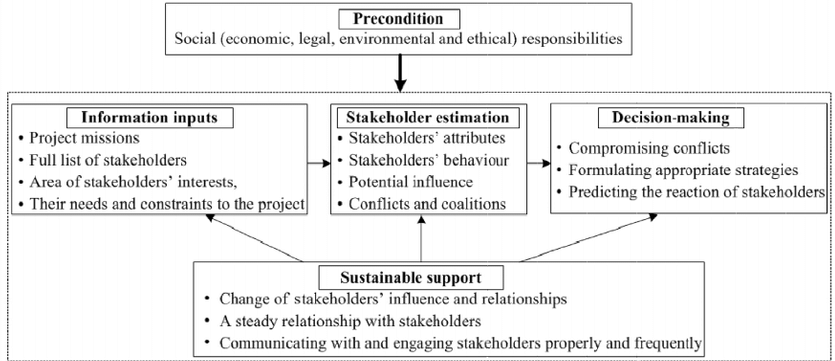 | Figure 2.1. Framework for successful stakeholder management in construction |
3. Research Methods
- This research adopted a quantitative research strategy. This research strategy is suitable for this study because it facilitates quick data collection, and the results are analysed using unbiased statistics. This research adopted a survey research design since data was collected at a single point in time. The researcher opted for this research design due to its versatility in exploring a wide range of topics. The research was conducted in Machakos County. Data was collected using questionnaires. A five-point Likert scale was adopted for the quantitative data.This study adopted content validity and face validity on the research instrument. To achieve content validity, the questionnaires were formulated according to the conceptual framework of this study. This ensured that the questionnaires measured only items related to the study variables. To achieve face validity, the researcher sought opinions from experts in the field to evaluate whether the research instrument appears to measure the intended construct. These experts were the supervisors of this research, who are leading academicians in construction project management and have a strong background in research methodology. Based on their feedback, it was confirmed that the instrument effectively measured what it was designed to, ensuring its validity.Reliability is a measure of the degree to which a research instrument yields consistent results or data on repeated trials [17]. To ensure internal reliability, expert reviews were conducted with the supervisors to ensure that all items were conceptually aligned and relevant to the construct of stakeholder management. The internal reliability of the instrument was tested using Cronbach’s alpha. The reliability test revealed that all the variables had good Cronbach's alpha coefficients ranging from 0.796 to 0.922. This implied that all the variables in this research had a high internal consistency. Therefore, the data collected was reliable.A total of 254 questionnaires were distributed to respondents. The respondents for this study included contractors, project consultants, ward development officers, end users, ward administrators, and village administrators. Out of the 254 questionnaires administered, 158 were filled out, collected, and returned. The overall response rate was 62.20%. According to [17], a response rate of 50% is adequate; 60% is a good response, while 70% is very good. Therefore, the response rate was acceptable and credible.The collected quantitative data were cleaned, coded, and entered into Statistical Package for Social Scientists (SPSS) version 23. Descriptive statistics were used to analyse data, which were then presented in tables and graphs.Inferential statistics included correlation and multiple regression analysis. Pearson’s Correlation (r) was used to reveal the strength of the relationship. Multiple linear regression helped to determine the relationship between stakeholder management practices and stakeholder management performance of County Government-funded construction projects in Machakos County. The researcher chose to use multiple linear regression because the study included multiple independent variables used to determine the outcome of a single dependent variable.Normality test for the variables was checked using Kurtosis and Skewness. For inferential analysis to be conducted the variables should have a normal distribution. Since the data was not normally distributed, it had to be transformed. The Z score values of all the variables were now between -1.96 and +1.96 as seen in Table 3.1. Therefore, the transformed data was normally distributed.
|
|
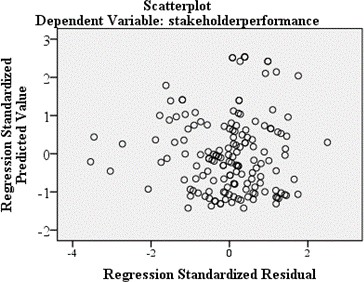 | Figure 3.1. Homoscedasticity and Linearity Scatterplot |
|
|
|
|
|
|
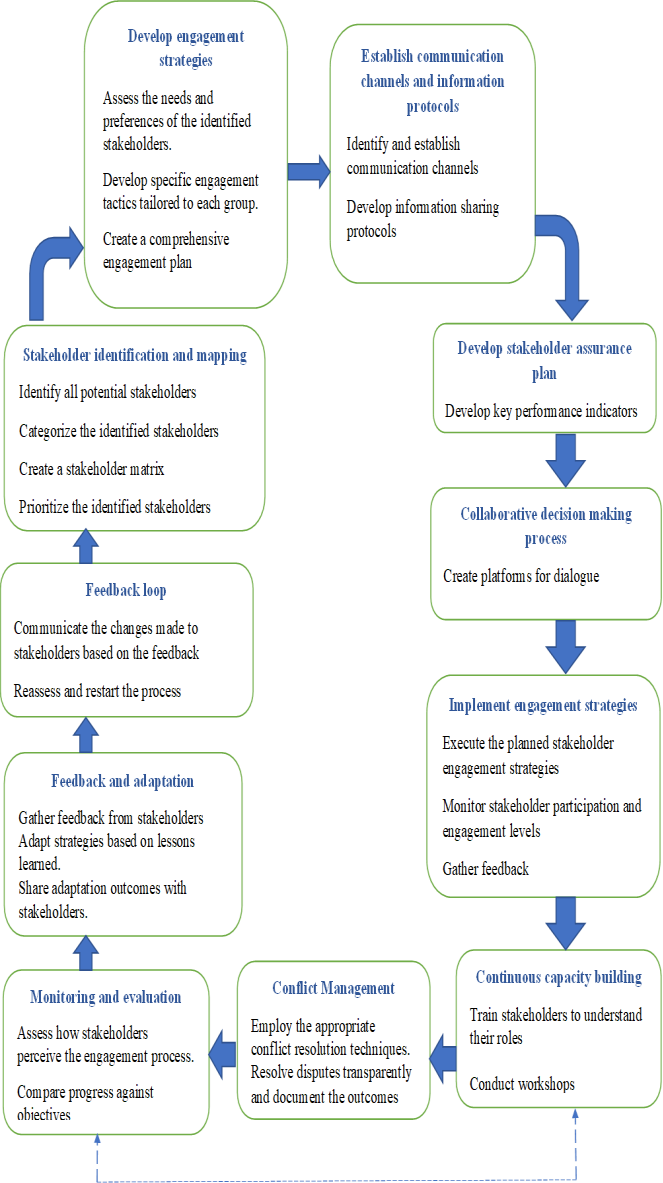 | Figure 3.2. Proposed Stakeholder Management Framework |
4. Conclusions and Recommendations
- This study concluded that:• Stakeholder management performance can be evaluated in terms of stakeholder diversity, stakeholder inclusivity and stakeholder satisfaction.• The level of stakeholder management performance is low in Machakos County.• The current stakeholder management practices in construction projects funded by Machakos County do not adequately meet the needs and expectations of stakeholders.• There is a need for a more comprehensive approach to stakeholder management in order to address the diverse interests and concerns of all relevant parties involved in construction projects funded by the County.• Enhancing stakeholder management practices can significantly improve overall stakeholder management performance.Practical RecommendationsThis research strongly recommends that counties adopt the developed stakeholder management framework to standardise stakeholder management practices across all their construction projects. The framework offers a structured approach for identifying, engaging, and monitoring stakeholders. This framework should be integrated into county policies, making it a mandatory requirement for all construction projects funded by the county. To ensure proper adoption, training workshops should be conducted for county officials and project managers to equip them with the necessary knowledge and tools. A pilot phase should be implemented in selected projects to test the framework's effectiveness before rolling it out county-wide. Moreover, counties are urged to give stakeholder management training through well-organized awareness campaigns. Counties should first identify key stakeholder groups and develop tailored training materials. These materials should be disseminated through brochures, videos, community meetings, and social media platforms to be as widely distributed as possible. The counties should also set up communication channels, such as help desks and feedback mechanisms to encourage continuous stakeholder engagement. To measure the effectiveness of these campaigns, counties should conduct periodic surveys and make improvements based on feedback received. These efforts will cultivate a sense of ownership and shared accountability among stakeholders.Finally, this study recommended that counties should set up mechanisms to conduct periodic performance assessment to continuously improve stakeholder management. Baseline performance assessments should be performed on ongoing and recently completed projects periodically to identify specific gaps and challenges. Counties should develop clear key performance indicators (KPIs) to evaluate the effectiveness of stakeholder management. Data should be collected through surveys and stakeholder interviews to analyse strengths and weaknesses in the management process. Findings should be reported in regular reports and necessary adjustments should be made to enhance approaches to stakeholder management. Institutionalizing these evaluations as a mandatory component of all county projects will promote continuous improvement.
 Abstract
Abstract Reference
Reference Full-Text PDF
Full-Text PDF Full-text HTML
Full-text HTML
